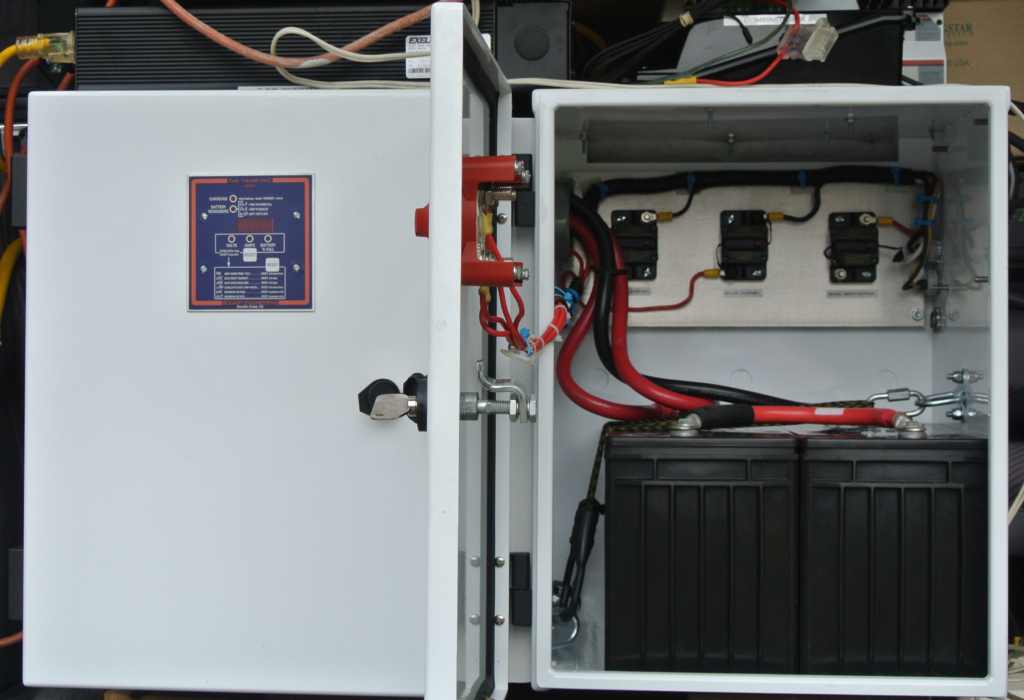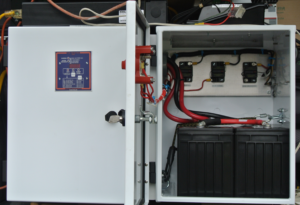Pairing solar with batteries, what you need to know

 (This article was written by Tobi Ogunnaike, a Summer 2015 Fellow)
(This article was written by Tobi Ogunnaike, a Summer 2015 Fellow)
Pairing low-cost energy storage with renewables is currently a hot topic of discussion. Tesla’s much-publicized entry into the renewable energy storage market is driving much of the interest. But the desire to pair solar with storage goes beyond just one company, because pairing the two just makes sense.
Adding storage to solar solves one of the main (if often irrelevant or inaccurate) criticisms of solar as an energy source: that it is intermittent. If we can pair cheap solar panels with cheap ways of storing the energy the solar panels produce, then we’re really onto something massive. The global solar landscape would be poised for a quantum leap.
Batteries offer reliable backup power. However, they remain expensive. If you want to pair batteries with PV systems – you have two options, either buying your PV system with batteries, or retrofitting your existing PV system with batteries.
Both options are feasible. Though, retrofitting your system is more expensive and more technically challenging. In this post, we’ll tackle some commonly asked questions concerning pairing PV systems with batteries so you can make an informed choice. There is no ‘one size fits all’ turnkey battery for residential solar purposes. Every product solution (battery bank system) is custom made to the individual’s needs.
Below we look at some common questions people have about solar and batteries.
How much do battery systems cost?
The cost of the PV system with batteries is roughly 30% higher than the cost of a standard grid-tied system without batteries. The value proposition of batteries is their ability to ensure reliable, backup power, not cost savings. Though that may change as the market matures and the price of battery technology drops.
How many appliances can I power with a typical battery bank system?
There is no ‘typical’ battery bank system. So, you can power as many appliances as you can afford.
Battery bank systems are always custom-made. They have to be because no two homes have the same energy usage, available space for solar modules, or financial circumstances. Installers size each battery system to meet the needs of individual customers.
This process involves determining how much electricity you want to store and for how long you would like to store it. Then your installer will select the appropriate battery type and number of batteries needed.
(More information here: http://www.openelectrical.org/wiki/index.php?title=Battery_Sizing )
What systems or hookups do I need to retrofit an existing battery-less system with batteries?
You will typically need:
- An additional inverter: Hybrid inverter/charger
- Load center
- Circuit breakers
- Electrical connections
- Battery bank
By retrofitting your existing PV system with batteries, you are going from a ‘grid-tied solar PV system’ to a ‘grid-interactive system’. Unless you replace some existing equipment, you would most likely be installing what’s called an ‘AC Coupled PV system’ – a type of grid interactive system
If you are yet to go solar, but are thinking about buying a system with batteries, you have another option. In this case, it is best to buy and install a solar PV system with the hybrid inverter from the outset. This is typically in a configuration known as a ‘DC Coupled’ because the batteries are on the same side of the inverter as the solar panels that are charging them.
This option gives you:
- Lower overall equipment costs (than installing batteries later)
- Simpler system design (only one inverter instead of two)
- Access to the 30% Federal Tax Credit for the battery system equipment. (Installing a battery system after PV is installed excludes that equipment from eligibility for the 30% credit.)
I have not yet gone solar. Should I get a battery system along with my PV system from the outset? Or can I just retrofit batteries later on?
If you are certain you want a battery, you should install it along with your solar system. Doing so lowers your equipment costs, simplifies your system design, and allows you use the 30% federal tax credit toward the cost of your battery system.
Getting batteries from the outset means you will typically buy a “DC Coupled” PV system. All this means is that the batteries are on the same side of the inverter as the solar panels that are charging them.
Why do I need a new inverter if I’m only adding batteries to my system?
Your system will need an inverter because you need a way to charge the batteries, and for the energy from the batteries to interact with your house when you need backup power. The batteries provide DC (direct current) energy and your house uses AC (alternating current) energy. The inverter is what switches the energy from DC to AC.
| Functionality | Hybrid inverter | Grid-tied inverter |
| Convert solar-generated DC power to AC power? | Yes | Yes |
| Charge batteries? | Yes | No |
| Enable energy storage? | Yes | No |
| Convert battery produced DC power into usable AC? | Yes | No |
| Can work with generator? | Yes | No |
| Bi-directional operation? | Yes | No |
| Relative ease of design and system integration | More difficult | Easier |
How does this new smart hybrid inverter compare with my existing inverter?
In an article with Solar Power World, Bryan Whitton – product manager at Darfon encapsulated the difference between both types of inverter:
“Inverters for grid-tied applications can only provide power based on what the array can immediately generate from the sun,” clarified Bryan Whitton. “Hybrid inverters can store power in batteries and then draw upon it as needed for energy stabilization.”
Can I use my battery system with micro inverters, central inverters or string inverters? How easily may I retrofit a battery system with micro vs. central inverter? Will this affect my warranties?
It depends on the installer’s technology and warranties. For reference, Enphase describes in this article, how their microinverters can be used with batteries. Make sure to confirm with your installer whether their warranties cover using a battery system with your specific type of inverter.
Can I go off grid with solar PV and batteries?
This is possible, but in the majority of cases, if you are already connected to the grid it is not in your interest to disconnect from it, even if most of your energy is coming from solar (with or without batteries).
Disconnecting from the grid will significantly raise your battery storage costs, as you will need to power your entire home with the stored energy from your system.
If you live in a remote area with limited access to the grid, or an area with extraordinarily high energy prices, then you may want to consider going off grid. But for most people today, sourcing power from solar PV and batteries alone will be not be an economically-beneficial decision. Significantly cheaper battery costs and ingenious technical solutions could change this in the future.
That said, it is technically feasible to do so if you wish to live off grid for other reasons. Here’s a great post by a man who’s lived off grid for 30 years.
Want other questions answered about batteries? Email us at mdteam@solarunitedneighbors.org. We’ll add questions and answers here as we hear from you.
